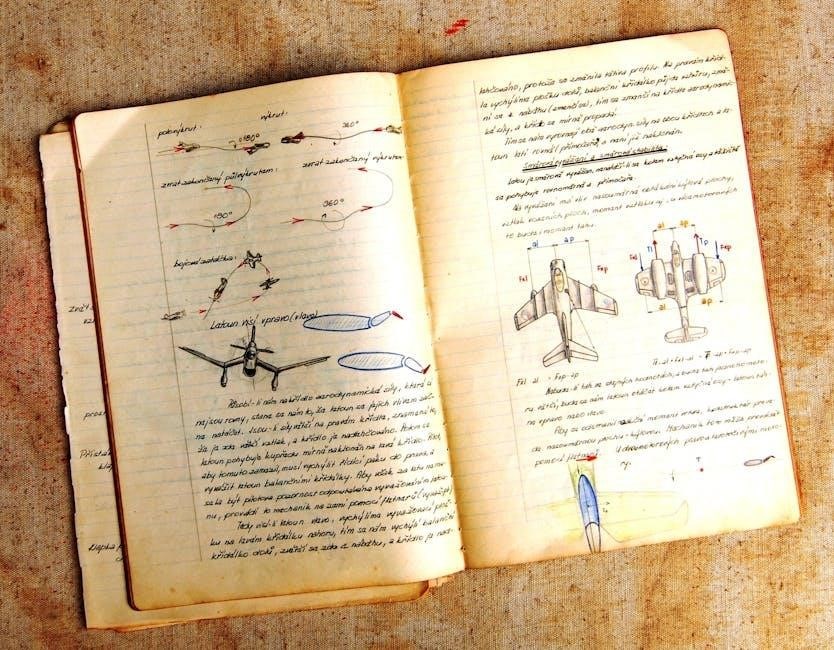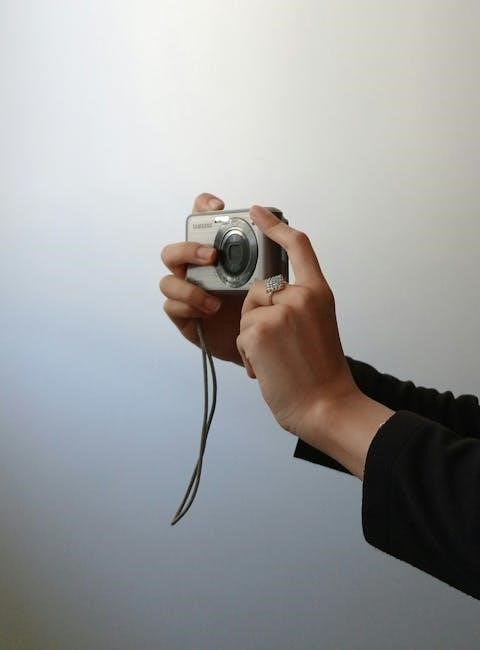Differential adjustment is a critical process in vehicle mechanics, ensuring proper gear alignment and backlash settings for optimal performance and durability. It requires precision and expertise.
1.1 Purpose of Differential Adjustment
The purpose of differential adjustment is to ensure proper gear alignment and backlash settings, critical for optimal performance and longevity. Correct adjustment prevents excessive wear, noise, and vibration, while ensuring smooth power transmission. Key objectives include achieving precise backlash and preload settings, essential for gear operation. This process involves measuring and setting the gap between gears and applying the correct tension to prevent movement. Following manufacturer guidelines is crucial, as improper adjustment can lead to mechanical failure. Specialized tools like dial indicators and torque wrenches are used to ensure accuracy. Regular adjustment extends the differential’s lifespan and maintains vehicle stability.
1.2 Importance in Vehicle Mechanics
Differential adjustment is vital for maintaining vehicle performance, stability, and longevity; Proper adjustment ensures smooth power transmission between wheels, prevents uneven tire wear, and reduces mechanical stress. Incorrect settings can lead to noise, vibration, or premature component failure. It plays a critical role in maintaining traction and control, especially in varying driving conditions. Skilled mechanics prioritize precise adjustments to avoid costly repairs and ensure optimal vehicle operation. Regular maintenance and accurate adjustments are essential for extending the lifespan of differential components and maintaining overall vehicle reliability.

Safety Precautions
Always wear protective gear, including gloves and goggles, when working on differentials. Ensure the workspace is clean and well-lit. Avoid using steel hammers, as they may damage components. Follow manufacturer guidelines to minimize risks during adjustment and testing. Proper safety measures prevent injuries and ensure accurate adjustments. Regularly inspect tools and equipment for damage or wear. Never proceed without securing the vehicle and ensuring all safety protocols are in place;
2.1 Essential Safety Measures
Wear protective gear, including gloves and safety goggles, to prevent injuries. Ensure the workspace is clean and well-lit, avoiding any flammable materials nearby. Secure the vehicle on jack stands and engage the parking brake to prevent accidental movement. Use only approved tools and avoid applying excessive force, which could damage components. Keep loose clothing and long hair tied back to prevent entanglement with machinery. Regularly inspect tools and equipment for damage or wear. Follow manufacturer guidelines for specific safety protocols. Never work under a vehicle without proper support. Ensure proper ventilation when using lubricants or cleaning agents. Safety is paramount to prevent accidents and ensure precise adjustments.
2.2 Protective Gear and Workspace Preparation
Always wear protective gear, including gloves, safety goggles, and steel-toe shoes, to safeguard against potential hazards. Ensure the workspace is clean, well-lit, and free from debris; Use jack stands to securely support the vehicle and engage the parking brake to prevent movement. Keep a fire extinguisher nearby and avoid wearing loose clothing. Ensure proper ventilation when handling lubricants or solvents. Organize tools and equipment neatly to avoid tripping hazards. Clear the area of flammable materials and ensure all machinery is turned off when not in use. A well-prepared workspace minimizes risks and ensures a safe, efficient adjustment process.

Tools and Equipment Required
The process requires specialized tools like dial indicators, torque wrenches, and gear mesh testers. Additional equipment includes micrometers, bearing pullers, and press tools for precise adjustments and disassembly.
3.1 Specialized Tools for Adjustment
Adjusting a differential requires specialized tools for precision and safety. Essential tools include a torque wrench for accurate preload settings, a dial indicator to measure backlash, and a micrometer for precise shim measurements. Additionally, bearing pullers and press tools are necessary for disassembling and reassembling components without damage. A gear mesh tester ensures proper tooth contact, while adjustment rings and shims are used to fine-tune gear alignment. These tools are critical for achieving the exact specifications outlined in repair manuals, ensuring optimal performance and longevity of the differential assembly.
3.2 Measurement Instruments (e.g., Dial Indicator)
A dial indicator is a crucial tool for measuring backlash and ensuring precise adjustments in differential maintenance. It is used to gauge the rotational play between the ring gear and pinion, ensuring proper mesh alignment. By mounting the dial indicator on the differential housing and rotating the pinion, technicians can accurately measure and adjust backlash to manufacturer specifications. Additionally, it is essential for verifying pinion preload and ensuring correct shim thickness. Precise measurements are vital to avoid gear damage and ensure smooth operation, making the dial indicator indispensable for differential adjustment procedures outlined in repair manuals. Accurate readings prevent premature wear and noise issues.
Disassembling the Differential
Disassembling the differential involves removing the pinion gear and carrier assembly, requiring precision to avoid damage. Specialized tools and adherence to manufacturer guidelines are essential for safe disassembly.
4.1 Removing the Pinion Gear
Removing the pinion gear is a delicate process requiring careful attention to avoid damage. Start by cleaning the contact faces of the pinion box and differential case. Install the pinion box without height adjustment shims in the differential case. Rotate the differential 180 degrees to access the pinion gear. Use specialized tools, such as a dial caliper, to measure and mark the gear’s position. Gently pry the pinion gear out, ensuring not to scratch or bend components. Once removed, inspect for wear or damage. Proper removal ensures a smooth reassembly process and maintains the differential’s integrity for optimal functionality.
4.2 Disassembling the Carrier Assembly
After removing the pinion gear, focus on disassembling the carrier assembly. Begin by taking out the side gears and bearings, ensuring all components are clean and free from debris. Use a hydraulic press to remove the bearings, taking care to avoid damage. Next, remove the carrier’s side rings, paying attention to their positioning for proper reinstallation. Lubricate all parts thoroughly to prevent corrosion. Inspect each component for wear or damage, replacing if necessary. Proper disassembly ensures a smooth reassembly process and maintains the differential’s performance and longevity. This step requires precision to avoid compromising the assembly’s structural integrity.

Measuring Backlash
Measuring backlash involves using a dial indicator to gauge the gap between the ring and pinion gears. Ensure clean, scratch-free surfaces and follow manufacturer specifications for accurate adjustments.
5.1 Understanding Backlash and Its Impact
Backlash refers to the gap between meshing teeth of the ring and pinion gears. Proper backlash ensures smooth operation, prevents premature wear, and avoids noise or vibration issues. Excessive backlash leads to gear damage and reduced performance, while insufficient backlash causes overheating and potential gear failure. Accurate measurement and adjustment are critical to maintaining optimal differential function and vehicle stability, especially during cornering or varying load conditions. Improper settings can compromise traction and safety, emphasizing the need for precise calibration as outlined in the manual.
5.2 Step-by-Step Measurement Process
To measure backlash accurately, mount the differential securely and rotate it to ensure proper gear mesh alignment. Attach a dial indicator to the pinion gear, positioning it perpendicular to the ring gear teeth. Rotate the differential slowly while observing the indicator readings to determine the total backlash. Compare the measurement to the manufacturer’s specifications. If backlash is incorrect, adjust the ring gear position by adding or removing shims. Repeat the process until the desired backlash is achieved. Ensure all measurements are precise to avoid gear damage, noise, or vibration during operation. This step is crucial for optimal differential performance and longevity.

Setting Pinion Preload
Precise pinion preload ensures proper gear engagement and minimizes wear. Adjust using a torque wrench, following manufacturer specifications, to achieve optimal tension for smooth operation and durability.
6.1 Methods for Adjusting Pinion Preload
Adjusting pinion preload involves tightening the pinion nut while measuring the resulting torque with a wrench. Rotate the pinion several times to seat bearings, then tighten gradually.
A dial indicator checks preload accuracy, ensuring it matches specifications. Over-tightening can damage bearings, while under-tightening leads to gear wear. Always refer to the manufacturer’s manual for specific torque values and procedures to ensure reliability and performance.
6.2 Using a Torque Wrench for Precise Adjustment
A torque wrench is essential for precise pinion preload adjustment. Tighten the pinion nut in small increments, checking torque regularly with the wrench. Rotate the pinion after each adjustment to ensure even preload distribution.
Refer to the manufacturer’s torque specification for accuracy. Marking the nut and shaft can help track progress. If equipped, use a dial indicator to verify preload. Proper torque ensures long-term durability and prevents damage to bearings or gears. Always follow the sequence outlined in the manual to avoid over-tightening or uneven stress distribution.
Adjusting Gear Mesh
Proper gear mesh adjustment ensures silent operation and prevents wear. Check contact patterns and adjust shims or bearings as needed for optimal alignment and smooth engagement.
7.1 Identifying Gear Mesh Issues
Identifying gear mesh issues is crucial for optimal differential performance. Common signs include abnormal noise, vibration, or excessive wear on gear teeth. Inspect the gear contact patterns for proper alignment and even distribution of wear. Use a dial indicator to measure backlash and ensure it falls within manufacturer specifications. Improper gear mesh can lead to premature wear, heat generation, and reduced efficiency. Visual inspection for pitting, scoring, or uneven tooth wear is essential. Early detection and correction prevent costly repairs and ensure smooth power transmission. Always refer to the manufacturer’s guidelines for specific diagnostic procedures and tolerance limits.
7.2 Correction Techniques for Optimal Mesh
Correcting gear mesh issues involves adjusting the pinion depth and backlash to achieve proper alignment. Use shims or spacers to modify the pinion position, ensuring the gear contact pattern is centered and even. Tighten bearings gradually and uniformly to avoid overloading. Measure with a dial indicator to confirm backlash within specifications. If wear is detected, replace gears or bearings as needed. Apply a thin layer of lubricant to prevent wear during reassembly. Ensure all bolts are torqued to manufacturer-recommended values. Proper mesh adjustment minimizes noise, reduces wear, and maximizes differential efficiency. Always follow the manufacturer’s specific correction procedures for precise results.

Reassembling the Differential
Reassemble the differential by reinstalling the pinion gear and carrier assembly, ensuring all parts are clean and properly aligned. Follow torque specifications for a secure fit.
8.1 Reinstalling the Pinion Gear
Reinstall the pinion gear by ensuring the contact faces of the pinion and differential case are clean and free of scratches. Apply the recommended lubricant to the gear teeth. Align the pinion gear with the carrier assembly, ensuring proper splined engagement. Hand-tighten the retaining nuts to secure the pinion in place. Use a torque wrench to tighten the nuts to the manufacturer’s specified torque value. Verify the pinion gear rotates smoothly and check for any abnormal play or noise. This step is crucial for maintaining proper gear mesh and ensuring the differential operates efficiently under various driving conditions.

8.2 Reassembling the Carrier Assembly
Reassemble the carrier by installing the bearings and side gears, ensuring all components are clean and properly lubricated. Align the bearings with the carrier housing, gently tapping them into place with a soft-faced hammer. Reattach the side gears, ensuring they mesh correctly with the pinion gear. Tighten the carrier bearing nuts in a star pattern using a torque wrench to the manufacturer’s specifications. Finally, inspect the assembly for any misalignment or excessive play. Rotate the carrier to ensure smooth operation and verify that all gears mesh properly without noise or resistance. Proper reassembly ensures optimal differential performance and longevity.

Setting Carrier Preload
Adjust the carrier bearings to achieve the correct preload, ensuring stability and preventing excessive movement. Use a torque wrench for precise tightening, following manufacturer specifications for optimal performance.
9.1 Adjusting Carrier Bearings
Adjusting carrier bearings involves tightening the bearing caps evenly to achieve the specified preload. Use a torque wrench to ensure accuracy, gradually tightening each bolt in a star pattern. Proper preload prevents bearing wear and ensures smooth operation. Refer to the manufacturer’s manual for specific torque values and sequences. Over-tightening can damage bearings, so careful measurement is essential. Once set, verify the preload with a dial indicator to confirm correct adjustment. This step is crucial for maintaining differential performance and longevity.
9.2 Final Tightening Procedures
Final tightening procedures involve securing all bolts and nuts to the specified torque values, ensuring the differential assembly remains stable and leak-free. Use a torque wrench to apply even pressure, following the manufacturer’s recommended sequence. Tighten bolts in a star pattern to avoid uneven stress on the housing. Once all components are securely fastened, verify the preload settings using a dial indicator to ensure no movement or play. Proper final tightening prevents vibration, noise, and premature wear. Always refer to the manual for exact torque specifications and tightening sequences to guarantee a reliable and durable adjustment. This step ensures optimal performance and longevity of the differential.
Verification and Testing
Verification involves checking backlash and preload settings using a dial indicator to ensure accuracy. Test driving the vehicle confirms smooth operation and identifies any post-adjustment issues promptly.
10.1 Checking Adjustment Accuracy
Checking adjustment accuracy ensures proper differential function. Use a dial indicator to measure backlash and preload, verifying they meet manufacturer specifications. Inspect gear mesh alignment and bearing preload. Ensure smooth rotation and no excessive noise. If readings deviate, repeat adjustments carefully. Accuracy is crucial for optimal performance, preventing future issues like vibration or wear. Always refer to the manual for specific tolerances and procedures.
10.2 Test Driving the Vehicle
Test driving is essential to verify differential adjustment accuracy. Drive in various conditions to ensure smooth operation. Check for unusual noises, vibrations, or performance issues. Accelerate and decelerate to test stability and responsiveness. Ensure proper traction and control, especially in turns. If issues arise, revisit adjustments following manual guidelines. This step confirms the differential functions as intended, providing a safe and reliable driving experience.

Troubleshooting Common Issues
Addressing noise, vibration, or performance issues post-adjustment requires identifying root causes. Check for incorrect backlash settings or uneven preload, and refer to the manual for corrective steps.
11.1 Identifying and Correcting Adjustment Errors
Common adjustment errors include excessive backlash, incorrect pinion preload, or improper gear mesh. These issues often result in noise, vibration, or reduced performance. To identify errors, inspect the backlash measurements and verify preload settings against manufacturer specifications. If noise persists, check for worn or damaged components. Correcting errors may involve resetting the backlash, adjusting carrier bearings, or replacing faulty parts. Always refer to the manual for precise adjustment procedures and ensure all measurements are accurate. Proper correction ensures smooth operation, prevents further damage, and extends the lifespan of the differential assembly. Regular verification post-correction is essential for optimal results.

11.2 Addressing Noise or Vibration Post-Adjustment
Noise or vibration after adjustment often indicates improper backlash settings or misaligned gears. Inspect the pinion and ring gear for wear or damage. Check preload measurements to ensure they meet specifications. If noise persists, verify gear mesh patterns and adjust as needed. Lubrication deficiencies may also contribute, so ensure all components are properly greased. In severe cases, replacing worn parts or re-shimming the gears may be necessary. Always test drive the vehicle post-repair to confirm resolution. Refer to the manual for diagnostic procedures and solutions to eliminate noise and vibration, ensuring a smooth and quiet operation of the differential system.
Resources for Further Learning
Consult recommended PDF manuals and online tutorials for detailed adjustment guides. These resources provide step-by-step instructions, troubleshooting tips, and video demonstrations to enhance your understanding and skills in differential adjustment.
12.1 Recommended PDF Manuals and Guides
For comprehensive guidance, download PDF manuals specific to your differential type, such as the Dana 44 or Toyota Land Cruiser models. These manuals provide detailed step-by-step instructions, diagrams, and specifications for adjusting backlash, setting preload, and troubleshooting common issues. They often include manufacturer-recommended tools and procedures, ensuring accuracy and safety. Websites like ManualsLib and AutoRepairManuals offer free downloads, while official manufacturer portals provide verified resources. Additionally, look for guides from reputable automotive forums and repair communities, which share real-world tips and solutions from experienced mechanics. These resources are invaluable for both beginners and professionals seeking to master differential adjustment techniques.
12.2 Online Tutorials and Video Resources
Supplement your learning with online tutorials and video guides available on platforms like YouTube and Udemy. Channels such as EricTheCarGuy and ChrisFix offer detailed walkthroughs of differential adjustment processes. These videos often include hands-on demonstrations, making complex procedures easier to understand. Additionally, forums like Reddit’s r/MechanicAdvice and specialized automotive websites provide interactive Q&A sessions and live demonstrations. For Spanish-speaking learners, tutorials on YouTube and forums like Mecánica Automotriz offer comprehensive guides tailored to specific vehicle models. These resources complement PDF manuals, providing visual and practical insights to enhance your adjustment skills effectively.
Differential adjustment is an intricate process requiring precision and adherence to guidelines. Proper execution ensures optimal vehicle performance and longevity, making it a vital mechanical skill to master.
13.1 Summary of Key Adjustment Steps
Differential adjustment involves several critical steps, starting with disassembly and inspection of components. Measuring backlash and setting pinion preload are essential for proper gear alignment. Adjusting gear mesh ensures smooth operation, while reassembling the differential requires careful alignment of components. Verifying adjustments with precision tools, such as dial indicators, guarantees accuracy. Final testing, including test drives, confirms the success of the adjustment. Adhering to manufacturer guidelines and safety protocols throughout the process is crucial for achieving optimal results and ensuring vehicle performance and longevity. Each step must be executed with precision to avoid errors and maintain the integrity of the differential system.
13.2 Final Tips for Successful Adjustment
Always refer to the manufacturer’s specifications for precise guidance. Use high-quality tools and ensure all components are clean and lubricated. Double-check measurements and adjustments to avoid errors. Perform a test drive to verify smooth operation and address any unusual noises. Keep a torque wrench handy for final tightenings. Use a dial indicator for accurate backlash measurements. Avoid over-tightening, as it can damage bearings. Consult the manual for specific torque values and adjustment sequences. Properly seal all openings after adjustments to prevent contamination. Regular maintenance and inspections can prevent future issues. Document your adjustments for future reference. Patience and attention to detail are key to a successful adjustment.